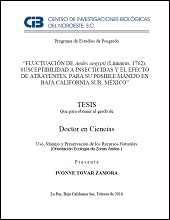“Fluctuación de Aedes aegypti (Linnaeus, 1762), susceptibilidad a insecticidas y el efecto de atrayentes, para su posible manejo en Baja California Sur, México”
Author
IVONNE TOVAR ZAMORA
Metadata
Show full item recordAbstract
El control de Aedes aegypti (Linnaeus, 1762) en México, requiere ser atendido y optimizado para disminuir la incidencia de las enfermedades conocidas como dengue, chikungunya y más recientemente zika. En la Región Sur de la Península de Baja California, se desconocen varios aspectos biológicos de este vector cuyo conocimiento ayudaría a mejorar su control. Por lo anterior los objetivos de este estudio fueron evaluar, estimar y determinar en poblaciones provenientes de La Paz (LAP), San José del Cabo (SJC) y Cabo San Lucas (CSL), la fluctuación poblacional de Ae. aegypti a lo largo de tres años de estudio, así también su estado de susceptibilidad a seis insecticidas usados para su control, los mecanismos de resistencia desarrollados hacia los insecticidas usados para su combate y, la atracción de las formas adultas de esta especie hacia cuatro sales sódicas derivadas de ácidos orgánicos, bajo condiciones de laboratorio para su posible uso en trampas. La fluctuación mensual en el número de huevos colectados fue significativamente más alta en LAP (p≤0.0001) de mayo a diciembre, no así en los colectados en SJC y SLC (p≤0.7924). Se obtuvo una correlación significativa entre el número de huevos y la temperatura mínima Rho≤0.60% (p≤0.01). La población de CSL fue menos susceptible a temefos (FR50= 8.25X), con mortalidades registradas de 69% a permetrina y 65.41% a bifentrina; mientras que las registradas de SJC fueron de 72.20% a bifentrina y 94.50% a malatión. En los mosquitos obtenidos de las tres localidades las concentraciones de esterasas y las glutatión-S-transferasas fueron significativamente más elevadas con respecto a la cepa susceptible (p≤0.000), así también las mutaciones kdr V1016I y F1534C estuvieron presentes con una frecuencia alélica ≥0.6% y ≥0.81%, respectivamente. En las pruebas de atracción, la mayor respuesta antenal se registró con el propionato de sodio (p<0.5) a una concentración de 250 ppm [...] Aedes aegypti (Linnaeus, 1762) control in Mexico needs to be optimized to reduce dengue, chikungunya and zika incidence. In the Southern Region of the Peninsula of Baja California, knowledge and comprehension of several biological aspects of this vector could improve their control. Therefore the objectives of this study were to evaluate, estimate and determine the population fluctuation over three years of study, the susceptibility to six insecticides used to control, the resistance mechanisms to insecticides, and the effect of four different organic acids as attractants of the adult forms under laboratory conditions for its possible use in traps from field mosquito populations collected in La Paz (LAP), San José del Cabo (SJ) and Cabo San Lucas (SL). The monthly fluctuation in the number of eggs collected was significantly higher in LAP (p≤0.0001) from May to December, not in those collected in SJ and SL (p≤0.7924). A significant correlation between the number of eggs and the minimum temperature Rho≤0.60% (p≤0.01) was obtained. SL's population was less susceptible to temephos (FR50= 8.25X), with mortalities recorded from 69% to 65.41% to permethrin and bifenthrin; whereas registered SJ were 72.20% to 94.50% bifenthrin and malathion. Esterases and glutathione-S-transferases were significantly higher compared to the susceptible strain (p≤0.000), and both kdr mutations V1016I and F1534C, were present with an allelic frequency of ≥ 0.6% and ≥ 0.81%, respectively, in mosquitoes collected from the three localities. Most electroantennographic studies esponse was recorded with sodium propionate (p <0.5) at a concentration of 250 ppm. These results provide important information about the behavior and status of insecticide resistance in Ae. aegypti from Baja California Sur that could be considered by the state program to optimize vector control
Collections
Related items
Showing items related by title, author, creator and subject.
-
PROMOCIÓN DEL PERIFITON PARA EL CULTIVO DE CAMARÓN BLANCO: HACIA UNA ACUICULTURA ECOLÓGICA
DOMENICO VOLTOLINA LOBINA; JUAN MANUEL AUDELO NARANJO; MARIA DEL ROSARIO PACHECO MARGES -
Suelo y Erosión
YOLANDA LOURDES MAYA DELGADO


